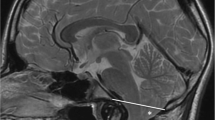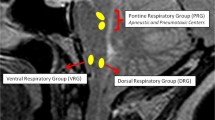Abstract
Introduction
The widespread use of imaging has increased Chiari malformation (CM) diagnosis. CM shows clinical heterogeneity that makes management controversial. We aimed to evaluate the occurrence and clinical and radiographic presentation of children with CM-1 and CM-1.5, reporting possible differences according to age and management.
Methods
We retrospectively reviewed 46 children diagnosed with CM-1 or CM-1.5, between 2006 and 2019 at our institute. We evaluated for each subject: reason for hospital admission, clinical presentation, age at diagnosis, extent of cerebellar tonsillar herniation (CTH) and type of treatment when carried out. Affected children were assigned to three age groups. In some patients, a clinical follow-up was carried out.
Results
Mean age at diagnosis was 7.61 years. Mean CTH was 8.72 mm. Syringomyelia was found in 10.9%. Twenty-six individuals (56.5%) were symptomatic. The most frequent symptom was headache (34.8%). There were no statistically significant differences between the age groups with regard to the amount of CTH (p = 0.81). Thirteen children (28.3%) underwent surgical treatment. CTH was significantly higher in the surgical group (p < 0.01). Twenty-three patients (50%) performed a 3-year mean follow-up, 17 of whom had no surgery treatment. CTH was stable in 58.8%, reduced in three and increased in three, without any change in symptoms. Only one child showed a worsening in herniation and symptoms, then requiring surgery.
Conclusion
Frequency and type of symptoms were consistent with those reported in the literature. Conservative approach is a viable option for minimally symptomatic patients, most of whom did not show clinical worsening at follow-up.




Similar content being viewed by others
References
Chiari H (1891) Ueber Veränderungen des Kleinhirns infolge von Hydrocephalie des Grosshirns. Dtsch Med Wochenschr 17(42):1172–1175. https://doi.org/10.1055/s-0029-1206803
Mancarella C, Delfini R, Landi A (2019) Chiari malformations. Acta Neurochir 125:89–95. https://doi.org/10.1007/978-3-319-62515-7_13
Horn SR, Shepard N, Vasquez-Montes D, Bortz CA, Segreto FA, De La Garza RR, Goodwin CR, Passias P (2018) Chiari malformation clusters describe differing presence of concurrent anomalies based on Chiari type. J Clin Neurosci 58:165–171. https://doi.org/10.1016/j.jocn.2018.06.045
Hidalgo JA, Tork CA, Varacallo M. Arnold Chiari Malformation. [Updated 2020 Jan 28]. In: StatPearls [Internet]. Treasure Island (FL): StatPearls Publishing; 2020 Jan. https://www.ncbi.nlm.nih.gov/books/NBK431076/
Bordes S, Jenkins S, Tubbs RS (2019) Defining, diagnosing, clarifying, and classifying the Chiari I malformations. Childs Nerv Syst 35(10):1785–1792. https://doi.org/10.1007/s00381-019-04172-6
Poretti A, Boltshauser E, Huisman TA (2016) Chiari malformations and syringohydromyelia in children. Semin Ultrasound CT MR 37(2):129–142. https://doi.org/10.1053/j.sult.2015.12.001
Kahn EN, Muraszko KM, Maher CO (2015) Prevalence of Chiari I malformation and syringomyelia. Neurosurg Clin N Am 26(4):501–507. https://doi.org/10.1016/j.nec.2015.06.006
Ciaramitaro P, Garbossa D, Peretta P et al (2020) Syringomyelia and Chiari Syndrome Registry: advances in epidemiology, clinical phenotypes and natural history based on a North Western Italy cohort. Ann Ist Super Sanita 56(1):48–58. https://doi.org/10.4415/ANN_20_01_08
Steinbok P (2004) Clinical features of Chiari I malformations. Childs Nerv Syst 20(5):329–331. https://doi.org/10.1007/s00381-003-0879-x
Novegno F (2019) Clinical diagnosis—part II: what is attributed to Chiari I. Childs Nerv Syst 35(10):1681–1693. https://doi.org/10.1007/s00381-019-04192-2
Tubbs RS, Beckman J, Naftel RP, Chern JJ, Wellons JC 3rd, Rozzelle CJ, Blount JP, Oakes WJ. Institutional experience with 500 cases of surgically treated pediatric Chiari malformation type I. J Neurosurg Pediatr 7(3):248–256. https://doi.org/10.3171/2010.12.PEDS10379
Toldo I, Tangari M, Mardari R, Perissinotto E, Sartori S, Gatta M, Calderone M, Battistella PA (2014) Headache in children with Chiari i malformation. Headache 54(5):899–908. https://doi.org/10.1111/head.12341
Elster AD, Chen MYM (1992) Chiari I malformations: clinical and radiologic reappraisal. Radiology 183(2):347–353. https://doi.org/10.1148/radiology.183.2.1561334
Meadows J, Kraut M, Guarnieri M, Haroun RI, Carson BS (2000) Asymptomatic Chiari Type I malformations identified on magnetic resonance imaging. J Neurosurg 92(6):920–926. https://doi.org/10.3171/jns.2000.92.6.0920
Aitken LA, Lindan CE, Sidney S, Gupta N, Barkovich AJ, Sorel M, Wu YW (2009) Chiari Type I malformation in a pediatric population. Pediatr Neurol 40(6):449–454. https://doi.org/10.1016/j.pediatrneurol.2009.01.003
Kelly MP, Guillaume TJ, Lenke LG (2015) Spinal deformity associated with Chiari malformation. Neurosurg Clin N Am 26(4):579–585. https://doi.org/10.1016/j.nec.2015.06.005
Greenlee J, Garell PC, Stence N, Menezes AH (2008) Comprehensive approach to Chiari malformation in pediatric patients. Neurosurg Focus 6(6):e4. https://doi.org/10.3171/foc.1999.6.6.7
Heiss JD, Patronas N, DeVroom HL, Shawker T, Ennis R, Kammerer W, Eidsath A, Talbot T, Morris J, Eskioglu E, Oldfield EH (1999) Elucidating the pathophysiology of syringomyelia. J Neurosurg 91(4):553–562. https://doi.org/10.3171/jns.1999.91.4.0553
Alexander H, Tsering D, Myseros JS et al (2019) Management of Chiari I malformations: a paradigm in evolution. Childs Nerv Syst 35(10):1809–1826. https://doi.org/10.1007/s00381-019-04265-2
Albert GW, Menezes AH, Hansen DR, Greenlee JD, Weinstein SL (2010) Chiari malformation Type I in children younger than age 6 years: presentation and surgical outcome. J Neurosurg Pediatr 5(6):554–561. https://doi.org/10.3171/2010.3.PEDS09489
Strahle J, Muraszko KM, Kapurch J, Bapuraj JR, Garton HJL, Maher CO (2011) Chiari malformation Type I and syrinx in children undergoing magnetic resonance imaging: clinical article. J Neurosurg Pediatr 8(2):205–213. https://doi.org/10.3171/2011.5.PEDS1121
Zabbarova A, Bogdanov E, Odin P, Kyoshima K, Pfleiderer S, Honig H, Mikhailov I (2012) Epidemiology of syringomyelia and chiari malformations: role of interpopulation studies of the phenotype of posterior cranial fossa. Neuroepidemiology, 39(3–4):240. https://www.embase.com/search/results?subaction=viewrecord&from=export&id=L70923062
Milhorat TH, Chou MW, Trinidad EM, Kula RW, Mandell M, Wolpert C, Speer MC (1999) Chiari I malformation redefined: clinical and radiographic findings for 364 symptomatic patients. Neurosurgery 44(5):1005–1017. https://doi.org/10.1097/00006123-199905000-00042
Krueger KD, Haughton VM, Hetzel S (2010) Peak CSF velocities in patients with symptomatic and asymptomatic Chiari I malformation. Am J Neuroradiol 31(10):1837–1841. https://doi.org/10.3174/ajnr.A2268
Saletti V, Viganò I, Melloni G, Pantaleoni C, Vetrano IG, Valentini LG (2019) Chiari I malformation in defined genetic syndromes in children: are there common pathways? Childs Nerv Syst 35(10):1727–1739. https://doi.org/10.1007/s00381-019-04319-5
de Souza RM, Zador Z, Frim DM (2011) Chiari malformation type I Related conditions. Neurol Res 33(3):278–284. https://doi.org/10.1179/016164111X1296220272392
Pindrik J, Johnston JM (2015) Clinical presentation of Chiari I malformation and syringomyelia in children. Neurosurg Clin N Am 26(4):509–514. https://doi.org/10.1016/j.nec.2015.06.004
Fernández AA, Guerrero AI, Martínez MI, Vázquez ME, Fernández JB, i Octavio EC, Labrado JL, Silva ME, de Araoz MF, García-Ramos R, Ribes MG, Gómez C, Valdivia JI, Valbuena RN, Ramón JR (2009) Malformations of the craniocervical junction (chiari type i and syringomyelia: Classification, diagnosis and treatment). BMC Musculoskelet Disord 10(Suppl 1):S1. https://doi.org/10.1186/1471-2474-10-S1-S1
Brockmeyer D, Gollogly S, Smith JT (2003) Scoliosis associated with chiari i malformations: the effect of suboccipital decompression on scoliosis curve progression. A preliminary study. Spine (Phila Pa 1976) 28(22):2505–2509. https://doi.org/10.1097/01.BRS.0000092381.05229.87
Isu T, Chono Y, Iwasaki Y, Koyanagi I, Akino M, Abe H, Abumi K, Kaneda K (1992) Scoliosis associated with syringomyelia presenting in children. Childs Nerv Syst 8(2):97–100. https://doi.org/10.1007/BF00298449
Hwang SW, Samdani AF, Jea A, Raval A, Gaughan JP, Betz RR, Cahill PJ (2012) Outcomes of Chiari I-associated scoliosis after intervention: A meta-analysis of the pediatric literature. Childs Nerv Syst 28(8):1213–1219. https://doi.org/10.1007/s00381-012-1739-3
Tubbs RS, Doyle S, Conklin M, Oakes WJ (2006) Scoliosis in a child with Chiari I malformation and the absence of syringomyelia: case report and a review of the literature. Childs Nerv Syst 22(10):1351–1354. https://doi.org/10.1007/s00381-006-0079-6
de Arruda JA, Figueiredo E, Monteiro JL, Barbosa LM, Rodrigues C, Vasconcelos B (2018) Orofacial clinical features in Arnold Chiari type I malformation: a case series. J Clin Exp Dent 10(4):e378–e382. https://doi.org/10.4317/jced.54419
Milhorat TH, Bolognese PA, Nishikawa M, McDonnell NB, Francomano CA (2007) Syndrome of occipitoatlantoaxial hypermobility, cranial settling, and chiari malformation type I in patients with hereditary disorders of connective tissue. J Neurosurg Spine 7(6):601–609. https://doi.org/10.3171/SPI-07/12/601
Grahovac G, Pundy T, Tomita T (2018) Chiari type I malformation of infants and toddlers. Childs Nerv Syst 34(6):1169–1176. https://doi.org/10.1007/s00381-017-3712-7
Ladner TR, Westrick AC, Wellons JC 3rd, Shannon CN (2016) Health-related quality of life in pediatric Chiari Type I malformation: the Chiari Health Index for Pediatrics. J Neurosurg Pediatr 17(1):76–85. https://doi.org/10.3171/2015.5.PEDS1513
Singhal A, Cheong A, Steinbok P (2018) International survey on the management of Chiari 1 malformation and syringomyelia: evolving worldwide opinions. Childs Nerv Syst 34(6):1177–1182. https://doi.org/10.1007/s00381-018-3741-x
Pomeraniec IJ, Ksendzovsky A, Awad AJ, Fezeu F, Jane JA (2016) Natural and surgical history of Chiari malformation Type I in the pediatric population. J Neurosurg Pediatr 17(3):343–352. https://doi.org/10.3171/2015.7.PEDS1594
Entezami P, Gooch MR, Poggi J, Perloff E, Dupin M, Adamo MA (2019) Current management of pediatric chiari type 1 malformations. Clin Neurol Neurosurg 176:122–126. https://doi.org/10.1016/j.clineuro.2018.12.007
Attenello FJ, McGirt MJ, Gathinji M, Datoo G, Atiba A, Weingart J, Carson B, Jallo GI (2008) Outcome of Chiari-associated syringomyelia after hindbrain decompression in children: analysis of 49 consecutive cases. Neurosurgery 62(6):1307–1313. https://doi.org/10.1227/01.neu.0000333302.72307.3b
Lu VM, Phan K, Crowley SP, Daniels DJ (2017) The addition of duraplasty to posterior fossa decompression in the surgical treatment of pediatric Chiari malformation Type I: a systematic review and meta-analysis of surgical and performance outcomes. J Neurosurg Pediatr 20(5):439–449. https://doi.org/10.3171/2017.6.PEDS16367
Dyste GN, Menezes AH, VanGilder JC (1989) Symptomatic Chiari malformations. An analysis of presentation, management, and long-term outcome. J Neurosurg 71(2):159–168. https://doi.org/10.3171/jns.1989.71.2.0159
Balestrino A, Consales A, Pavanello M, Rossi A, Lanteri P, Cama A, Piatelli G (2019) Management: opinions from different centers—the Istituto Giannina Gaslini experience. Child’s Nerv Syst 35(10):1905–1909. https://doi.org/10.1007/s00381-019-04162-8
Tubbs RS, Iskandar BJ, Bartolucci AA, Oakes WJ (2004) A critical analysis of the Chiari 1.5 malformation. J Neurosurg 101(2 Suppl):179–183. https://doi.org/10.3171/ped.2004.101.2.0179
Chatrath A, Marino A, Taylor D, Elsarrag M, Soldozy S, Jane JA (2019) Chiari I malformation in children—the natural history. Childs Nerv Syst 35(10):1793–1799. https://doi.org/10.1007/s00381-019-04310-0
Whitson WJ, Lane JR, Bauer DF, Durham SR (2015) A prospective natural history study of nonoperatively managed Chiari I malformation: does follow-up MRI surveillance alter surgical decision making? J Neurosurg Pediatr 16(2):159–166. https://doi.org/10.3171/2014.12.PEDS14301
Acknowledgements
The authors wish to thank American Manuscript Editors (USA) for editing the manuscript.
Funding
This research did not receive any specific grant from funding agencies in the public, commercial, or not-for-profit sectors.
Author information
Authors and Affiliations
Corresponding author
Ethics declarations
Conflict of interest
The authors declare that they have no conflict of interest.
Ethical approval
The study conforms to The Code of Ethics of the World Medical Association (Declaration of Helsinki). This is a retrospective study and no free informed consent form was needed, and subject’s identity was not divulged.
Additional information
Publisher's Note
Springer Nature remains neutral with regard to jurisdictional claims in published maps and institutional affiliations.
Rights and permissions
About this article
Cite this article
Giallongo, A., Pavone, P., Tomarchio, S.P. et al. Clinicoradiographic data and management of children with Chiari malformation type 1 and 1.5: an Italian case series. Acta Neurol Belg 121, 1547–1554 (2021). https://doi.org/10.1007/s13760-020-01398-z
Received:
Accepted:
Published:
Issue Date:
DOI: https://doi.org/10.1007/s13760-020-01398-z




